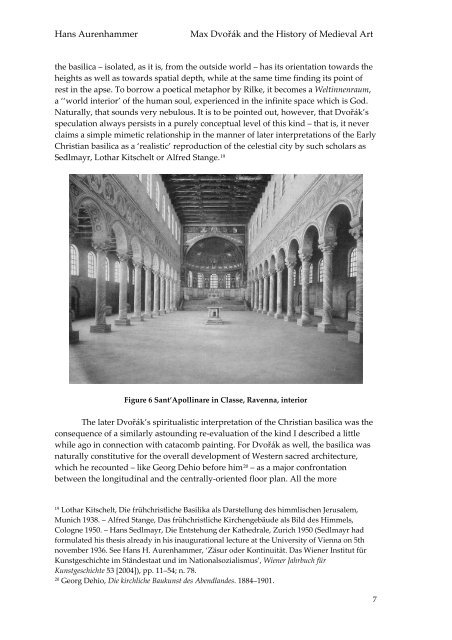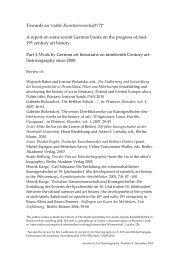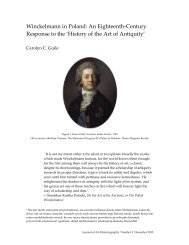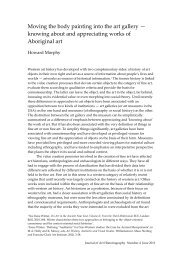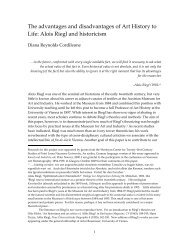Max Dvorák und die Revision der Mittelalter-Kunstgeschichte im ...
Max Dvorák und die Revision der Mittelalter-Kunstgeschichte im ...
Max Dvorák und die Revision der Mittelalter-Kunstgeschichte im ...
Create successful ePaper yourself
Turn your PDF publications into a flip-book with our unique Google optimized e-Paper software.
Hans Aurenhammer <strong>Max</strong> Dvořák and the History of Me<strong>die</strong>val Art<br />
the basilica – isolated, as it is, from the outside world – has its orientation towards the<br />
heights as well as towards spatial depth, while at the same t<strong>im</strong>e finding its point of<br />
rest in the apse. To borrow a poetical metaphor by Rilke, it becomes a Weltinnenraum,<br />
a ‘‘world interior’ of the human soul, experienced in the infinite space which is God.<br />
Naturally, that so<strong>und</strong>s very nebulous. It is to be pointed out, however, that Dvořák’s<br />
speculation always persists in a purely conceptual level of this kind – that is, it never<br />
cla<strong>im</strong>s a s<strong>im</strong>ple m<strong>im</strong>etic relationship in the manner of later interpretations of the Early<br />
Christian basilica as a ‘realistic’ reproduction of the celestial city by such scholars as<br />
Sedlmayr, Lothar Kitschelt or Alfred Stange. 19<br />
Figure 6 Sant’Apollinare in Classe, Ravenna, interior<br />
The later Dvořák’s spiritualistic interpretation of the Christian basilica was the<br />
consequence of a s<strong>im</strong>ilarly asto<strong>und</strong>ing re-evaluation of the kind I described a little<br />
while ago in connection with catacomb painting. For Dvořák as well, the basilica was<br />
naturally constitutive for the overall development of Western sacred architecture,<br />
which he recounted – like Georg Dehio before h<strong>im</strong>20 – as a major confrontation<br />
between the longitudinal and the centrally-oriented floor plan. All the more<br />
19 Lothar Kitschelt, Die frühchristliche Basilika als Darstellung des h<strong>im</strong>mlischen Jerusalem,<br />
Munich 1938. – Alfred Stange, Das frühchristliche Kirchengebäude als Bild des H<strong>im</strong>mels,<br />
Cologne 1950. – Hans Sedlmayr, Die Entstehung <strong>der</strong> Kathedrale, Zurich 1950 (Sedlmayr had<br />
formulated his thesis already in his inaugurational lecture at the University of Vienna on 5th<br />
november 1936. See Hans H. Aurenhammer, ‘Zäsur o<strong>der</strong> Kontinuität. Das Wiener Institut für<br />
<strong>Kunstgeschichte</strong> <strong>im</strong> Ständestaat <strong>und</strong> <strong>im</strong> Nationalsozialismus’, Wiener Jahrbuch für<br />
<strong>Kunstgeschichte</strong> 53 [2004]), pp. 11–54; n. 78.<br />
20 Georg Dehio, Die kirchliche Baukunst des Abendlandes. 1884–1901.<br />
7


